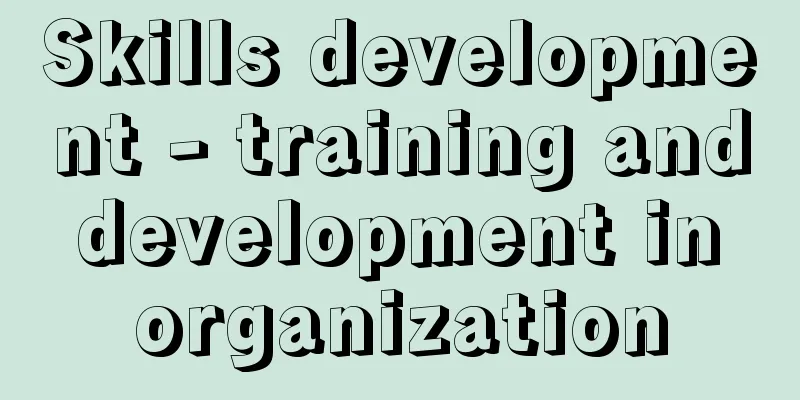Skills development - training and development in organization

|
Capacity building refers to an organizational and systematic effort to improve the learning and development of members in order to improve the effectiveness of individuals, teams, and organizations. It is carried out within organizations such as companies, organizations, and government agencies. [Techniques for capacity development] One of the earliest attempts at capacity development backed by psychology can be seen in the sensitivity training practiced by Lewin, K. Sensitivity training is a training technique for increasing interpersonal sensitivity and flexibly changing one's attitudes and behavior to suit the situation. In small groups, members talk to each other only about what is happening "here and now," learning through experience the impact their own actions and hidden feelings have on others and how to interact with others. Through this training, members can acquire the interpersonal consideration and emotional stability necessary for a group leader. In-house training is a concrete approach to capacity development. Education and training in the workplace has been mainly considered to be divided into on-the-job training (OJT) and off-the-job training (Off-JT). OJT refers to the acquisition of knowledge, skills, and abilities required for the job while actually performing the job. It is the most widely used method of capacity development in the industrial field, not only in Japan. Because of its extremely high prevalence, it includes various initiatives at the workplace. It can take various forms, such as spontaneous informal methods in which the trainee is assigned a job and learns as he or she works, methods in which the trainee imitates the way an experienced worker works, a senior colleague is assigned as an instructor and looks after the trainee, and formal, planned methods in which the supervisor regularly follows up through interviews and worksheets. As part of OJT, job rotation may be considered, whereby the employee's work responsibilities and assignments are changed periodically and systematically, allowing the employee to experience several different jobs. In addition, if the employee learns his/her own way of doing the job through consultation with an external coach, or if the employee is taught by a senior employee with a lot of experience in the workplace, this training is called coaching. Coaching refers to the employee acquiring the knowledge, skills, and ways of thinking necessary to achieve his/her goals through repeated dialogue with the coach. Furthermore, if a specific hierarchical or master-disciple relationship develops between the employee and the senior employee during the skill formation process, this may take the form of mentoring. Mentoring refers to a person with a wealth of knowledge and experience (a mentor) paying attention to the professional and career aspects of a young person (a protégé) who is still immature, and providing social and psychological support. On the other hand, Off-JT refers to training and education that is conducted outside the workplace. Its content is diverse. For example, lectures and reading of specialized books (classroom learning and seminars) are traditional and the most familiar Off-JT methods. Other Off-JT methods that focus on mutual interaction among participants include the case method, in which participants read a case example and then analyze the situation, identify the cause, and plan countermeasures with the assistance of a mediator called a facilitator; group discussion, in which participants discuss a common problem with other group members to come up with a solution; and role-play, in which participants play a set role in a given scenario or situation, learning the behavior of the person involved and the emotions of the other person when they are in that position. Furthermore, as technologically advanced learning methods, multimedia education that uses Internet technology to learn using various media such as web videos and software, and e-learning, which uses the Internet and PCs in addition to multimedia such as text, video, and audio, as well as program learning and final exams. [Effectiveness measurement] After conducting training, it is essential to evaluate its effectiveness. This is because it is impossible to conclude whether the training was meaningful without conducting an evaluation of training effectiveness. Kirkpatrick, DL, has listed four stages as standards for measuring the effectiveness of training. That is, the reaction (satisfaction) standard is a questionnaire survey conducted after the training to capture the opinions and satisfaction of the participants, the learning (achievement) standard is a written test or report to evaluate the learning achievement, the behavior (transformation) standard is a change in behavior shown in the workplace after the training, captured through interviews with the participants themselves and evaluation by others, and the result (achievement) standard is a measure of the overall effect obtained by the training from the perspective of the entire organization. On the other hand, in order to evaluate the effectiveness using the same standard as the cost, an evaluation method called utility analysis has been developed as a technique for converting the effectiveness of training into monetary terms. This is because using economic indicators (monetary terms) as the standard makes it easier for managers and executives to realize the effectiveness of the training. When viewed from the perspective of the organization as a whole, if a company is implementing initiatives including OJT and Off-JT, it can be said that the system for capacity development is in place. However, in recent years, the perception has changed that the ideal form of good in-house training is not to provide training that is highly satisfying, but that good capacity development is when participants return to the workplace and contribute to intellectual productive activities. Therefore, it is necessary to evaluate the effectiveness of training at the level of changing employee behavior and improving the performance of the entire workplace. [Kiyoshi Takahashi] Latest Sources Psychology Encyclopedia Latest Psychology Encyclopedia About Information |
|
能力開発とは,個人やチームや組織の効果性を向上させるために実践される成員の学習と発達に関する組織的・体系的な取り組みを指す。企業・団体・官庁など組織内で実施される。 【能力開発の諸技法】 心理学に裏づけられた能力開発の試みは,レビンLewin,K.によって実践された感受性訓練sensitivity trainingに,その最も初期の活動が見て取れる。感受性訓練とは,対人関係の感受性を高め,状況に合わせて自分の態度や行動を柔軟に変容させるための訓練技法である。小集団のなかで,メンバーが「今,ここで」起こっていることだけに限定して互いに話し合い,自分の行動や隠された感情が他者に与える影響や,他者との相互作用の仕方を,体験を通じて学び取っていく。この訓練によって,グループのリーダーとして必要な対人配慮や情緒の安定などを身につけることができるのである。 企業内訓練inhouse trainingは能力開発の具体的な取り組みである。職場における教育訓練は,もっぱらon-the-job training(OJT)とoff-the-job training(Off-JT)に区別して考えられてきた。OJTとは,対象者が実際に仕事をやりながら,職務に必要な知識や技能や能力を習得することを指している。わが国に限らず,産業場面で最も広く実施されている能力開発の方法である。その普及率がきわめて高いために,現場でのさまざまな取り組みを含んでいる。対象者に仕事を割り当てて,仕事をやらせながら覚えさせる自然発生的なインフォーマルのものや,熟練者の仕事の仕方を見てまねるもの,職場の先輩を教育係に割り当て,対象者の面倒を見させるといったようなもの,上司が面談やワークシートを活用して,定期的にフォローアップするフォーマルで計画的なものなど,さまざまな形態をもつ。 OJTの一環として,定期的・計画的に仕事の担当や配属を替え,いくつかの職務を経験させるジョブ・ローテーションを含めて考えることもある。また,外部コーチとの相談を通じて自分なりの仕事のやり方を身につけていったり,経験の長い職場の先輩から職務上で教えを請うような場合であれば,コーチングとよばれる訓練となる。コーチングcoachingとは,コーチと対話を重ねることによって,対象者が自分の目標達成に必要な知識,技能,ものの考え方を体得することを指す。さらに,技能形成の過程で,先輩との間に特定の上下関係や師弟関係が芽生えれば,メンタリングという形式を取ることもある。メンタリングmentoringとは,知識や経験の豊かな人(メンター)が,いまだ未熟な若年者(プロテジェ)に対して,職業面・キャリア面で目をかけたり,社会面・心理面でサポートを行なうことをいう。 一方,職場外に場所を移して実施される研修や訓練をOff-JTとよぶ。その中身は多彩である。たとえば,講義(レクチャー)や専門書講読(座学やセミナー)は伝統的であり,最も慣れ親しんだOff-JTの方法である。また,参加メンバー同士の相互交流を中心にすえたものとしては,ケース事例を読んだ後に,ファシリテーターとよばれる仲介者の補助によってケースの状況分析や原因把握,対策立案などを行なっていくケースメソッドや,共通の課題について,グループメンバーと議論をすることによって解決策をまとめていくグループディスカッション,シナリオや状況が与えられた中で,参加者が決められた役割を演じることによって,その立場に立ったときの当事者の行動や相手の感情を学習するロールプレイなどがある。さらに,技術的に進化した学習方法として,インターネット技術を活用し,ウェブ動画やソフトウェアなどの多様なメディアを使って学習を行なうマルチメディア教育や,テキスト・映像・音響などのマルチメディアに加えて,プログラム学習や修了試験などを,ウェブとPCを併用して実施するeラーニングなども活用されている。 【効果測定】 研修を実施した後には,その効果を評価することが肝心である。研修効果測定evaluation of training effectivenessを行なわなければ,研修を実施した意義があったかどうかを結論づけることができないからである。研修効果を測定するための基準として,カークパトリックKirkpatrick,D.L.は四つの段階を挙げている。すなわち,研修終了後にアンケート調査等を行ない,参加者の意見や満足度をとらえる反応(満足度)基準,筆記試験やレポートなどを実施し,学習到達度を評価する学習(到達度)基準,研修後に職場で示した行動の変化を,参加者自身へのインタビューや他者評価からとらえる行動(変容度)基準,組織全体で見て,研修によって得られた効果の総体を測る結果(成果達成度)基準である。他方,コストと同じ基準で効果を評価するために,研修の効果を金額に換算する技法として,効用分析とよばれる評価方法が開発されている。経済指標(金額)を基準にすれば,経営者や管理者にとって最も研修効果を実感しやすいからである。 組織全体として見て,OJTとOff-JTを含めた取り組みが企業内で実施されていれば,能力開発のための制度は整っているといえる。しかし近年,満足度が高い研修を実施することが良い企業内訓練のあり方ではなく,参加者が職場に戻って知的生産活動に寄与できてこそ,良い能力開発のあり方だという認識に変わってきている。よって,従業員の行動変容や職場全体の成果向上というレベルでの効果を,研修に関して評価していく必要がある。 〔高橋 潔〕 出典 最新 心理学事典最新 心理学事典について 情報 |
<<: Ability test - nouryokukentei
Recommend
Pawpaw - Popo (English spelling) Pawpaw
A deciduous tall tree of the Annonaceae family, pa...
Kingdom of Luang Prabang - Kingdom of Luang Prabang
The first kingdom of Laos was formed in the 14th c...
Opoyaz - Opoyaz (English spelling)
The "Society for the Study of Poetic Language...
Byakurensha (English spelling) Bo-lian-she
A Chinese Buddhist association. It began in the fi...
Lord Kanashi - Ushuganashi
...During the reign of Sho Shin, who reigned for ...
Kyoto Red Flag Incident
…High Treason Incident (2) An incident that occur...
Uchima Palace
<br /> The remains of a mansion in Kadekari,...
Home-style shamisen notation - Home-style shamisen notation
...However, most of the scores published are for ...
Alalakh (English spelling)
An ancient city located in the Orontes River basin...
Yu Hao (English spelling)
?-989 Chinese architect of the early Northern Song...
Tiger
...Ethiopia is home to 70-80 languages belongin...
Kisui
…The total length is 2,620 km, and the drainage a...
Industrial Art
... However, while crafts were considered industr...
Caesareia - Caesareia
…Population: 454,000 (1994). An ancient trading c...
Azo pigment - azo pigment
A general term for organic pigments that have the ...









